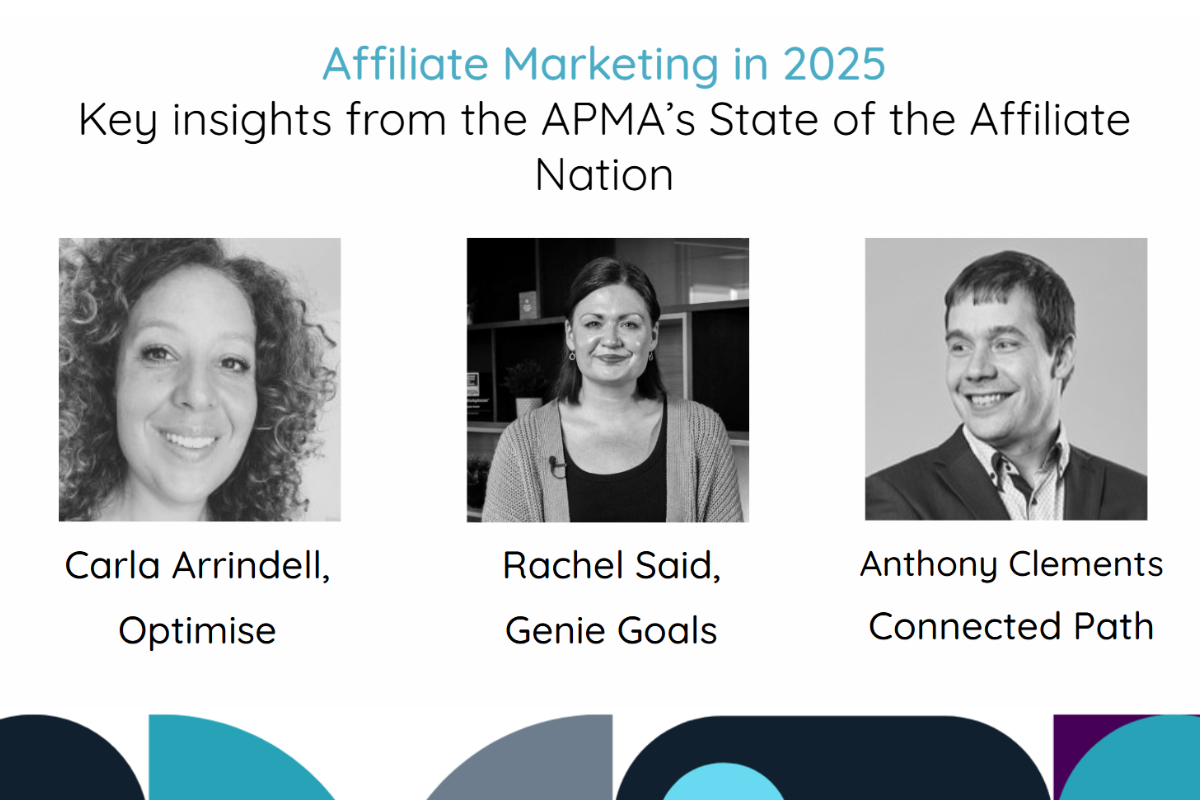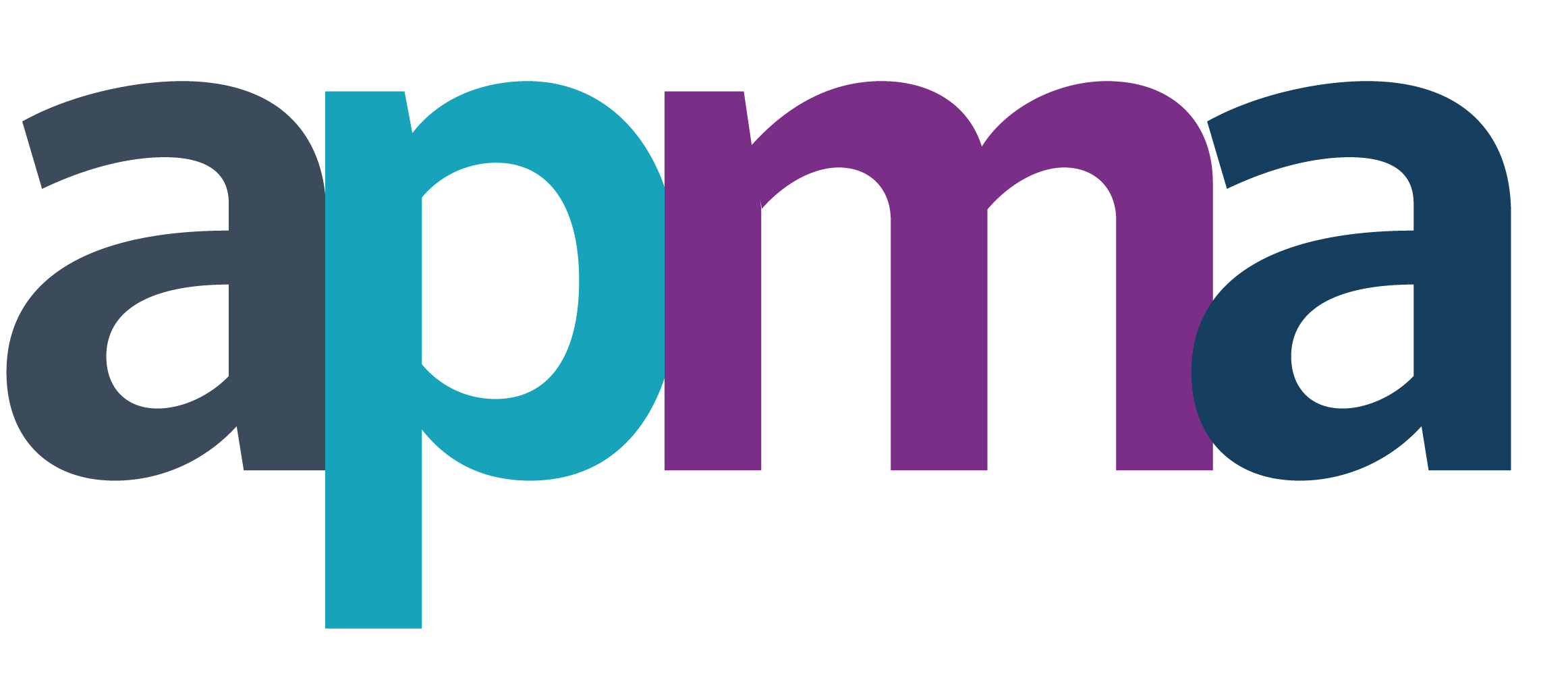
The UK affiliate marketing industry defied economic headwinds throughout 2024. As the APMA’s State of the Nation report explains, this is a marketing channel that is not merely surviving, it’s thriving.
We invited three APMA members to discuss the findings of this year’s report in a webinar last month.
Carla Arrindell from Optimise, Rachel Said from Genie Goals and Ant Clements of Connected Path joined Kevin to digest and dissect the numbers. Drawing on data from 12 leading networks (plus modelled figures for Amazon Associates), our independent research reveals a market that grew by 9% and generated £19 billion in basket revenue last year.
For APMA members, these insights serve as both a benchmark and a call to action. Watch the webinar in full, or read our write-up of our panellists’ perspectives as they offer their thoughts on how affiliate marketing can maintain its momentum into 2026.
Affiliate’s resilience in a flat economy
Although the UK economy registered only 1.5% growth in 2024, affiliate marketing’s total advertiser spend surged to £1.7 billion, up 9% year-on-year. As Carla highlighted, “When broader digital budgets are under pressure, brands double down on performance-driven channels.”
Indeed, in 2024, every £1 spent on affiliate commissions and network fees returned roughly £16 in basket revenue, an ROI that comfortably outpaces most other digital channels.
Behind those headline numbers, affiliates logged 362 million attributed sales, nearly one million transactions per day, driving more than £50 million in orders daily, even in a fragile consumer climate.
Which verticals are outpacing the market?
Retail commands just under 50% of affiliate budgets, but its overall share edged down slightly from 49% in 2023. A growing number of nimble e-commerce brands are experimenting with comparison shopping services (CSS) and content-driven programmes to capture incremental, lower-funnel traffic.
Rachel noted that retailers are now keen to diversify across the affiliate purchase path; “brands want to invest in early funnel, but they still feel as though the channel isn’t necessarily well placed to reward that activity. That said, it does feel that there’s been a gear change over the last couple of years to want to try and find solutions to be able to do that.”
This shift is shown in the growth of CSS spend (14%) as more retailers run CSS alongside PPC to capture new customer traffic higher in the funnel.
Meanwhile, travel affiliates generated roughly £5 billion in bookings, about 14% of the UK’s £36 billion online travel market. This share underscores travel’s robust post-COVID recovery, as consumers shopped around for deals on flights, hotels, and packages.
Finance and tech partners driving growth
Finance and telecom each held smaller but still meaningful shares of affiliate spend, driven largely by credit-card acquisition, current-account switching offers, broadband packages, and mobile promotions. In particular, fintech, tech partners, comparison engines, pre-approval APIs, and mortgage-oriented aggregators registered 26% year-on-year growth.
Banks are now integrating these partners with pre-approval checks, API-driven product matching, and pre-populated applications all of which boost conversion rates and allow advertisers to reach intent-ready users. As cost-of-living pressures prompted more consumers to compare banking products, finance brands expanded from credit cards into current accounts, mortgages, and personal loans, further fueling tech-partner budgets.
Coupon sites contract, subnetworks expand
Pure voucher and coupon sites saw a 7% contraction in budgets, but some of this could be due to some joining subnetworks which grew 18% in spend share. Google’s late-2023 site-reputation algorithm update may have played out in the numbers.
By contrast, Content & Influencers accounted for just 6% of affiliate spend in 2024, growing only 1 percent point year-on-year. Despite widespread belief that influencer marketing is booming, affiliate-driven content programs remain under-leveraged. Carla pointed out that content affiliates often cost more but it’s an investment brands are willing to make. Conversions may be low but she stressed the importance of measuring success through metrics like audience reach or brand lift, which don’t always translate into immediate sales.
Consequently, many brands still underwrite content creation via fixed fees rather than performance models. To capture more upper-funnel dollars, APMA members should explore hybrid CPC+CPA structures, paying for engagement first, then topping up on a completed sale.
The rise of non-last-click models
Last-click CPA remains the backbone of the channel, about 87% of affiliate budgets, but non-last-click CPA (CPC deals, tenancies, hybrid models) climbed to roughly 13% this past year.
Rachel explained that a “blended ROI story” is crucial: by investing earlier in the funnel via CPC deals on high-traffic newsletters or hybrid pricing models. This approach not only broadens brand awareness but also nurtures prospects through to conversion, improving overall program efficiency.
For APMA members, this shift means it’s time to rethink legacy budget allocations. If your affiliate strategy remains 100% last-click, you risk missing a growing segment of consumers who discover brands via content, community channels, or comparison tools well before the ultimate purchase.
Cashback & Loyalty: the industry engine
Cashback and loyalty programs secured nearly 29% of affiliate budgets in 2024 making them the single largest category. Under UK ICO rules, cashback and loyalty affiliates can now operate with consent exemptions that avoid cookie blocking. Consumers love earning cashback, and brands appreciate the double-digit ROI these programs deliver. Ant mentioned they will see double-digit growth again in 2025, potentially surpassing nascent channels like retail-media networks.
Black Friday & peak period takeaways
During the four-day Black Friday/Cyber Weekend (Friday to Monday), affiliates captured around 13% of UK online retail spend, up from a 10% share during the rest of the year.
This figure demonstrates that affiliate programs consistently outperform across peak shopping periods. As Rachel added, building unique offers for affiliate partners, such as exclusive vouchers, early CSS bids, or bonus loyalty points redeemable only via affiliate links, communicated well in advance is essential. Underinvesting in Q4 affiliate activations can leave millions of pounds on the table, especially as consumers flock to deal sites and influencers for last-minute inspiration.
Looking forward…
1. AI’s impact on content (Carla)
Affiliates should prepare for AI “answer blocks” to cannibalise organic search traffic to editorial sites. As AI summaries and price comparisons become more sophisticated, traditional content affiliates risk losing clicks if they remain solely reliant on static blog posts. To stay relevant, publishers need to develop interactive tools, community-driven insights, subscription models, or “calculator-style” widgets that engage users before search engines display the answer directly. Those who adapt packaging expertise into modular, AI-friendly assets, will continue to capture attention; others may find themselves relegated to page two.
2. CPC-driven influencer & content models (Rachel)
Performance-driven influencer campaigns are on the rise. Brands are testing CPC or cost-per-engagement models for social and creator partnerships, replacing flat-fee arrangements. Platforms like Linkby enable influencers to earn based on actual traffic rather than mere impressions. By tying payouts directly to on-site engagement, advertisers can unlock previously unused budgets, bring upper-funnel influencer spend under the affiliate umbrella, and improve transparency.
3. Cashback & Loyalty outpacing retail media (Ant)
Cashback programs already enjoy preferential consent exemptions, and their ROI continues to outshine many emerging channels. We would expect additional revenue from that exemption to kick in across 2025’s numbers. In turn the extra revenue and tracking accuracy could help loyalty and reward to further consolidate their position. Could that lead to a two-tier approach to affiliate marketing?
For APMA members looking to capitalise on these trends, we recommend the following action points:
1. Audit your affiliate mix
If your budgets remain wedded to last-click CPA exclusively, shift some towards non-CPA models this year. Ringfence a ‘test and learn’ budget. Engage a CSS partner if you haven’t already, and explore CPC sponsorships with high-traffic newsletters or top-tier influencers.
2. Refine your taxonomy
Affiliate self-classification and categories can be misleading and inconsistent. Ensure you spend time creating your own categorisation based on the values and metrics important to you.
3. Double down on peak opportunities
Black Friday/Cyber Weekend is an event built for affiliate marketing. Plan in the summer if you fully want to embrace the opportunity and have a full three-month strategy. Communicate early to maximise uptake.
4. Nurture tech partnerships
There are more than 100 tech partners active in the affiliate space today. Understand the range of activity they offer and whether you have gaps they can plug. They offer brilliant shortcuts for brands looking to scale that don’t have the internal resources, expertise and knowledge to tackle challenges directly. Finance brands in particular are seeing significant success.
5. Prepare for AI disruption
Content affiliates can no longer rely on organic search alone. Identify ways to repurpose editorial IP into AI-friendly components: interactive calculators, live price-feed tables, chatbot “assistants”. Ensure consumers engage with your brand before AI summaries cannibalise clicks. But make sure when you do appear in those summaries, you’re optimizing for revenue.
Final thoughts
The “State of the Affiliate Nation 2025” report is our annual mark in the sand, serving as both a mirror on who we are and a map for future growth.
It reflects how far the channel has come, with an extra £350k spent on the channel every day across 2024 compared to the previous year. We’re seeing an increasingly sophisticated approach to commissioning and this represents a major opportunity for reinvention.
Our collective challenge in 2025 is to remain agile, experiment boldly, and double down on partnerships that deliver results. Affiliate marketing’s best days are still ahead, and we want to write the next chapter in its story.
APMA members can download this year’s full report for FREE. Please log in to the members’ area or reach out to the team for access.
Buy the full 60-page State of the Nation Report here.
_________________________________________________________________________
We also have a free highlights version of the report. Fill in our form to get your copy.


